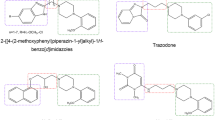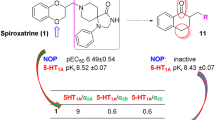Abstract
A series of 51 5-HT2A partial agonistic arylethylamines (primary or benzylamines) from different structural classes (indoles, methoxybenzenes, quinazolinediones) was investigated by fragment regression analysis (FRA), docking and 3D-QSAR approaches. The data, pEC50 values and intrinsic activities (Emax) on rat arteries, show high variability of pEC50 from 4 to 10 and of Emax from 15 to 70%. FRA indicates which substructures affect potency or intrinsic activity. The high contribution of halogens in para position of phenethylamines to pEC50 points to a specific hydrophobic pocket. Other results suggest the significance of hydrogen bonds of the aryl moiety for activation and the contrary effect of benzyl groups on affinity (increasing) and intrinsic activity (decreasing). Results from fragment regression and data on all available mutants were considered to derive a common binding site at the rat 5-HT2A receptor. After generation and MD simulations of a receptor model based on the β2-adrenoceptor structure, typical derivatives were docked, leading to the suggestion of common interactions, e.g., with serines in TM3 and TM5 and with a cluster of aromatic amino acids in TM5 and TM6. The whole series was aligned by docking and minimization of the complexes. The pEC50 values correlate well with Sybyl docking energies and hydrophobicity of the aryl moieties. With this alignment, CoMFA and CoMSIA approaches based on a training set of 36 and a test set of 15 compounds were performed. The correlation of pEC50 with steric, electrostatic, hydrophobic and H-bond acceptor fields resulted in sufficient fit (q 2: 0.75–0.8, r 2: 0.92–0.95) and predictive power (r 2pred : 0.85–0.88). The important interaction regions largely reflect the patterns provided by the putative binding site. In particular, the fit of the aryl moieties and benzyl substituents to two hydrophobic pockets is evident.




Similar content being viewed by others
Abbreviations
- h5-HT2AR:
-
Human 5-HT2A receptor
- r5-HT2AR:
-
Rat 5-HT2A receptor
- hβ2AR:
-
Human β2 adrenoceptor
- GPCR:
-
G-protein coupled receptor
- TM:
-
Transmembranous segment
- FRA:
-
Fragment regression analysis
- CoMFA:
-
Comparative molecular field analysis
- CoMSIA:
-
Comparative molecular similarity index analysis
- PLS:
-
Partial least squares analysis
- PC:
-
Principal component
- 3D-QSAR:
-
Three-dimensional quantitative structure–activity relationships
References
Peroutka SJ (1990) 5-Hydroxytryptamine receptor subtypes. Pharmacol Toxicol 67:373–383
Rapport MM, Green AA, Page IH (1947) Purification of the substance which is responsible for vasoconstrictor activity of serum. Fed Proc 6:184
Rapport MM, Green AA, Page IH (1948) Serum vasoconstrictor (serotonin): isolation and characterization. J Biol Chem 176:1243–1251
Roth BL, Willins DL, Kristiansen K, Kroeze WK (1998) 5-Hydroxytryptamine2-family receptors (5-hydroxytryptamine2A, 5-hydroxytryptamine2B, 5-hydroxytryptamine2C): where structure meets function. Pharmacol Ther 79:231–257
Zifa E, Fillion G (1992) 5-Hydroxytryptamine Receptors. Pharmacol Rev 44:401–457
Nichols DE, Nichols CD (2008) Serotonin receptors. Chem Rev 108:1614–1641
Braden MR, Parrish JC, Naylor JC, Nichols DE (2006) Molecular interaction of serotonin 5-HT2A receptor residues Phe339(6.51) and Phe340(6.52) with superpotent N-benzyl phenethylamine agonists. Mol Pharmacol 70:1956–1964
Heim R (2003) Synthesis and pharmacology of potent 5-HT2A receptor agonists with N-2-methoxybenzyl partial structure. Dr. rer. nat. PhD Thesis, Free University, Berlin
Elz S, Kläß T, Warnke U, Pertz HH (2002) Development of highly potent partial agonists and chiral antagonists as tool for the study of 5-HT2A-receptor mediated function. Naunyn-Schmiedeberg’s Arch Pharmacol 365:R29
Halter CC (2004) Mescaline analogs as partial 5-HT2A receptor agonists: Synthesis and pharmacological in vitro testing. Dipl. chem. Diploma thesis, University Regensburg, Regensburg
Heim R, Pertz HH, Walther I, Elz S (1998) Congeners of 3-(2-Benzylaminoethyl)-2, 4-quinazolindione: partial agonists for rat vascular 5-HT2A receptors. Naunyn-Schmiedeberg’s Arch Pharmacol 358:R105
Heim R, Pertz HH, Zabel M, Elz S (2002) Stereoselective synthesis, absolute configuration and 5-HT2A agonism of chiral 2-methoxybenzylamines. Arch Pharm Pharm Med Chem 335:82
Pertz HH, Heim R, Elz S (2000) N-benzylated phenylethanamines are highly potent partial agonists at 5-HT2A receptors. Arch Pharm Pharm Med Chem 333:30
Ratzeburg K, Heim R, Mahboobi S, Henatsch J, Pertz HH, Elz S (2003) Potent partial 5-HT2A-receptor agonism of phenylethamines related to mescaline in the rat tail artery model. Naunyn-Schmiedeberg’s Arch Pharmacol 367:R31
Cherezov V, Rosenbaum DM, Hanson MA, Rasmussen SG, Thian FS, Kobilka TS, Choi HJ, Kuhn P, Weis WI, Kobilka BK, Stevens RC (2007) High-resolution crystal structure of an engineered human beta2-adrenergic G protein-coupled receptor. Science 318:1258–1265
Rasmussen SG, Choi HJ, Rosenbaum DM, Kobilka TS, Thian FS, Edwards PC, Burghammer M, Ratnala VR, Sanishvili R, Fischetti RF, Schertler GF, Weis WI, Kobilka BK (2007) Crystal structure of the human beta2 adrenergic G-protein-coupled receptor. Nature 450:383–387
Gasteiger E, Gattiker A, Hoogland C, Ivanyi I, Appel RD, Bairoch A (2003) ExPASy: the proteomics server for in-depth protein knowledge and analysis. Nucleic Acids Res 31:3784–3788
Wang J, Wolf RM, Caldwell JW, Kollman PA, Case DA (2004) Development and testing of a general amber force field. J Comput Chem 25:1157–1174
Lovell SC, Word JM, Richardson JS, Richardson DC (2000) The penultimate rotamer library. Proteins 40:389–408
Strasser A, Striegl B, Wittmann HJ, Seifert R (2008) Pharmacological profile of histaprodifens at four recombinant histamine H-1 receptor species isoforms. J Pharmacol Exp Ther 324:60–71
Van der Spoel D, Lindahl E, Hess B, Groenhof G, Mark AE, Berendsen HJC (2005) GROMACS: fast, flexible, and free. J Comput Chem 26:1701–1718
Oostenbrink C, Villa A, Mark AE, Van Gunsteren WF (2004) A biomolecular force field based on the free enthalpy of hydration and solvation: the GROMOS force-field parameter sets 53A5 and 53A6. J Comput Chem 25:1656–1676
Sealfon SC, Chi L, Ebersole BJ, Rodic V, Zhang D, Ballesteros J, Weinstein H (1995) Related contribution of specific helix 2 and 7 residues to conformational activation of the serotonin 5-HT2A receptor. J Biol Chem 28:16683–16688
Wang CD, Gallaher TK, Shih JC (1993) Site-directed mutagenesis of the serotonin 5-hydroxytrypamine2 receptor: identification of amino acids necessary for ligand binding and receptor activation. Mol Pharmacol 43:931–940
Almaula N, Ebersole BJ, Zhang D, Weinstein H, Sealfon SC (1996) Mapping the binding site pocket of the serotonin 5-Hydroxytryptamine2A receptor. Ser3.36(159) provides a second interaction site for the protonated amine of serotonin but not of lysergic acid diethylamide or bufotenin. J Biol Chem 271:14672–14675
Johnson MP, Loncharich RJ, Baez M, Nelson DL (1994) Species variations in transmembrane region V of the 5-hydroxytryptamine type 2A receptor alter the structure-activity relationship of certain ergolines and tryptamines. Mol Pharmacol 45:277–286
Johnson MP, Wainscott DB, Lucaites VL, Baez M, Nelson DL (1997) Mutations of transmembrane IV and V serines indicate that all tryptamines do not bind to the rat 5-HT2A receptor in the same manner. Molecular Brain Research 49:1–6
Shapiro DA, Kristiansen K, Kroeze WK, Roth BL (2000) Differential modes of agonist binding to 5-hydroxytryptamine(2A) serotonin receptors revealed by mutation and molecular modeling of conserved residues in transmembrane region 5. Mol Pharmacol 58:877–886
Choudhary MS, Craigo S, Roth BL (1993) A single point mutation (Phe340-->Leu340) of a conserved phenylalanine abolishes 4-[125I]iodo-(2, 5-dimethoxy)phenylisopropylamine and [3H]mesulergine but not [3H]ketanserin binding to 5-hydroxytryptamine2 receptors. Mol Pharmacol 43:755–761
Choudhary MS, Sachs N, Uluer A, Glennon RA, Westkaemper RB, Roth BL (1995) Differential ergoline and ergopeptine binding to 5-hydroxytryptamine2A receptors: ergolines require an aromatic residue at position 340 for high affinity binding. Mol Pharmacol 47:450–457
Ballesteros JA, Weinstein H (1995) Integrated methods for the construction of three-dimensional models and computational probing of structure-function relations in G protein-coupled receptors. Methods Neurosci 25:366–428
Clark M, Cramer I RD, Van Opdenbosch N (1989) Validation of the general purpose tripos 5.2 force field. J Comp Chem 10:982–1012
Glennon RA, Westkaemper RB, Bartyzel P (1991) Serotonin receptor subtypes: basic and clinical aspects. In: Venter CJ, Harrison LC, Peroutka SJ (eds) Receptor biochemistry and methodology. Wiley-Liss, New York, pp 19–64
Giger R (1989) Actual Chim Ther 16:151–186
Cramer I RD, Patterson DE, Buce JD (1988) Comparative molecular field analysis (CoMFA): effect of shape on binding of steroids to carrier protein. J Am Chem Soc 110:5959–5967
Klebe G, Abraham U, Mietzner T (1994) Molecular similarity indices in a comparative analysis (CoMSIA) of drug molecules to correlate and predict their biological activity. J Med Chem 37:4130–4146
Folkers G, Merz A, Rognan D (1993) CoMFA: Scope and Limitations. In: Kubinyi H (ed) 3D QSAR in drug design: theory, methods and applications. ESCOM, Leiden, pp 583–618
Wold S, Ruhe A, Wold H, Dunn WJ (1984) The covariance problem in linear regression. The partial least squares (PLS) approach to generalized inverses. SIAM J Sci Stat Comp 5:735–743
Cramer I RD, Buce JD, Petterson DE (1988) Crossvalidation, bootstrapping, and partial least squares compared with multiple regression in conventional QSAR studies. Quant Struct-Act Relat 7:18–25
Clark RD, Fox PC (2004) Statistical variation in progressive scrambling. J Comput Aided Mol Des 18:563–576
Golbraikh A, Tropsha A (2002) Beware of q(2)!. J Mol Graph Model 20:269–276
Doweyko AM (2004) 3D-QSAR illusions. J Comput Aided Mol Des 18:587–596
Roth BL, Choudhary MS, Khan N, Uluer AZ (1997) High-affinity agonist binding is not sufficient for agonist efficacy at 5-hydroxytryptamine2A receptors: evidence in favor of a modified ternary complex model. J Pharmacol Exp Ther 280:576–583
Roth BL, Shoham M, Choudhary MS, Khan N (1997) Identification of conserved aromatic residues essential for agonist binding and second messenger production at 5-hydroxytryptamine2A receptors. Mol Pharmacol 52:259–266
Warne T, Serrano-Vega MJ, Baker JG, Moukhametzianov R, Edwards PC, Henderson R, Leslie AGW, Tate CG, Schertler GFX (2008) Structure of a β1-adrenergic G-protein-coupled receptor. Nature 454:U482–U486
Scheerer P, Park JH, Hildebrand PW, Kim YJ, Krauss N, Choe HW, Hofmann KP, Ernst OP (2008) Crystal structure of opsin in its G-protein-interacting conformation. Nature 455:497–503
Kubinyi H, Hamprecht FA, Mietzner T (1998) Three-dimensional quantitative similarity-activity relationships (3D QSiAR) from SEAL similarity matrices. J Med Chem 41:2553–2564
Ghose AK, Viswanadhan VN, Wendoloski JJ (1998) Prediction of Hydrophobic (Lipophilic) Properties of Small Organic Molecules Using Fragmental Methods: An Analysis of ALOGP and CLOGP Methods. J Phys Chem 102:3762–3772
Heiden W, Moeckel G, Brickmann J (1993) A new approach to analysis and display of local lipophilicity/hydrophilicity mapped on molecular surfaces. J Comput Aided Mol Des 7:503–514
Acknowledgments
This work was supported by the Graduate Training Program (Graduiertenkolleg) GRK 760, “Medicinal Chemistry: Molecular Recognition - Ligand-Receptor Interactions”, of the Deutsche Forschungsgemeinschaft.
Author information
Authors and Affiliations
Corresponding author
Rights and permissions
About this article
Cite this article
Silva, M.E., Heim, R., Strasser, A. et al. Theoretical studies on the interaction of partial agonists with the 5-HT2A receptor. J Comput Aided Mol Des 25, 51–66 (2011). https://doi.org/10.1007/s10822-010-9400-2
Received:
Accepted:
Published:
Issue Date:
DOI: https://doi.org/10.1007/s10822-010-9400-2




